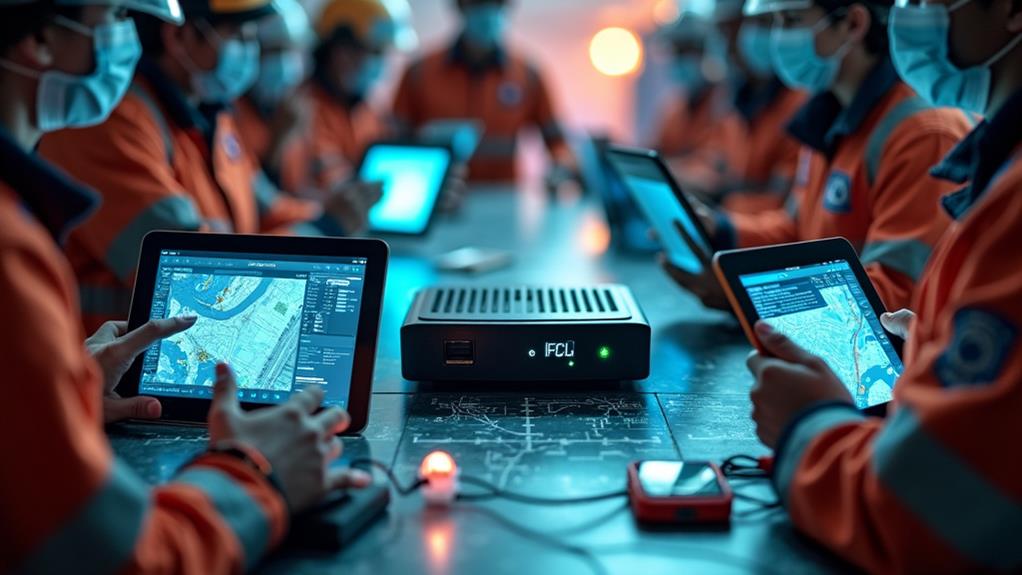



When it comes to IoT (Internet of Things) projects, you're likely seeking compact and efficient hardware that can operate effectively in diverse environments. You want cost-effective, power-efficient mini PCs that can adapt to varied applications without skimping on performance. In the next section, we will explore the key features to ponder when selecting the ideal mini PC for your IoT project.
Key Takeaways
- When selecting a mini PC for IoT projects, consider factors such as processor performance, RAM, storage, connectivity options, and operating system compatibility.
- Popular mini PC choices for IoT include Raspberry Pi, ASUS Tinker Board, Intel NUC, Odroid single-board computers, and SolidRun ClearFog Pro.
- Integrating mini PCs into IoT system designs involves connecting sensors and actuators, handling edge computing and data processing, and integrating with clouds and remote management.
- Key capabilities to compare in mini PCs for IoT include processor speed and cores, memory and storage, networking and wireless features, peripheral and expansion options, and power consumption and thermal management.
- For IoT projects, mini PCs offer benefits such as low cost and power efficiency, compact form factors, flexible software customization, and ease of deployment and scalability.
Mini PC for IoT Projects
When it comes to selecting a computing platform for IoT projects, mini PCs like the Raspberry Pi and Intel NUC are popular choices due to their compact size, low power consumption, and versatile connectivity options. The Raspberry Pi, an affordable single-board computer, is widely used in IoT applications such as home automation, sensor networks, and edge computing. This is because it can efficiently manage and analyze data from devices and sensors while ensuring low power consumption.
Alternatively, Intel NUC mini PCs offer more processing power and support for advanced operating systems like Windows and Linux, making them suitable for industrial IoT and edge analytics. In these applications, the Intel NUC's capability to handle more complex data processing and run more robust software is essential.
These mini PCs are designed specifically for IoT applications, providing features like PoE, 4G connectivity, and customization options. Additionally, their edge computing capabilities enable real-time data processing and decision-making closer to the source, reducing latency and bandwidth requirements in IoT systems.
Key Features to Consider
When working on IoT projects, it's essential to select the right mini PC based on specific requirements. The first consideration should be the processor performance and energy efficiency. This guarantees that data processing and machine learning tasks are executed effectively at the edge. Some key features to ponder when choosing the best mini PC for your IoT project:
- Processor Performance and Energy Efficiency: Look for mini PCs with powerful yet energy-efficient processors that can handle data processing and machine learning tasks efficiently.
- Connectivity Options: Ensure the mini PC supports various connectivity options such as Ethernet, Wi-Fi, Bluetooth, and cellular to seamlessly integrate with IoT sensors, devices, and cloud platforms.
- Compact and Fanless Designs: Compact and fanless designs allow for deployment in space-constrained environments and harsh conditions common in IoT applications.
- Flexible Operating System Support: Select mini PCs that support versatile operating systems like Linux and Windows 10 IoT to run a variety of IoT software and frameworks.
Advantages for IoT Solutions
With their compact size, efficient performance, and versatile connectivity, mini PCs provide a powerful and cost-effective solution for IoT projects. These small yet capable devices seamlessly integrate into IoT ecosystems, offering flexible operating system choices like Linux or Windows IoT. This flexibility allows you to tailor your IoT applications to your specific needs.
One significant advantage of mini PCs for IoT solutions is their powerful processing capabilities. This enables advanced data analytics and machine learning at the edge, ensuring real-time decision-making for SMART SOLUTIONS. Whether using a mini PC stick to manage sensors and actuators or deploying a network of IoT devices, these small PCs can handle it all.
Count on mini PCs to provide reliable connectivit …
Comparing Mini PC and Raspberry
Both Mini PCs and Raspberry Pis offer compelling options for IoT projects, but it is indispensable to compare their characteristics carefully to determine which is best suited for your specific needs. When deciding, consider the following key differences:
- Processing Power: Mini PCs typically offer more processing power, making them ideal for more demanding IoT applications.
- Cost: Raspberry Pis are generally more affordable, appealing to hobbyists and educational projects on a budget.
- Connectivity Options: Mini PCs offer a wider range of connectivity options, including Ethernet, USB, and HDMI, while Raspberry Pis have a more limited set.
- Form Factor: Raspberry Pis are known for their small size and low power consumption, making them ideal for space-constrained deployments.
Mini PCs, designed for various tasks, enable developers to build powerful and responsive IoT systems. For example, they are well-suited for remote monitoring applications where high processing power is required. In contrast, Raspberry Pis are perfect for smaller-scale projects or IoT applications where power consumption needs to be minimal. Understanding these differences will help you choose the right device for your IoT project.
IoT Applications and Deployment
As you prepare to deploy IoT solutions, it is vital to ponder the versatility and scalability of mini PCs, which enable you to tailor your infrastructure to specific use cases and easily adapt to evolving requirements. Mini PCs designed for the Internet of Things (IoT) offer several key advantages, particularly for industrial IoT and intelligent, responsive city implementations. Their compact form factor and low power consumption make them ideal for remote, often-inaccessible locations. IoT applications that require real-time processing and decision-making can greatly benefit from the edge computing capabilities of these devices.
With the ability to run various OS and be easily managed remotely, mini PCs provide a reliable backbone for your IoT infrastructure. They can seamlessly integrate with other IoT devices and systems, ensuring high levels of interoperability. Additionally, their low initial and ongoing costs, compared to traditional servers, help make IoT solutions more accessible and cost-effective. As your IoT network expands, mini PCs can be scaled to meet growing demands, ensuring continuous support for your projects. Over time, as technology advances, these mini PCs will continue to improve and enhance smart city infrastructures, industrial IoT networks, and more.
Cost-Saving and Expansion
Cost savings and scalability are essential for IoT deployments. When it comes to cost-saving and expansion, mini PCs offer a compelling solution. Here are the key benefits of using mini PCs for your IoT projects:
- Flexible Integration: Mini PCs can easily integrate into existing IoT ecosystems, reducing deployment costs and optimizing space utilization.
- Customization and OEM Services: Manufacturers provide customization and OEM services to tailor the hardware and software to meet specific IoT requirements.
- Energy Efficiency: Mini PCs are designed to be energy-efficient and often fanless, making them ideal for deployment in harsh or remote environments.
- Seamless Connectivity: They offer flexible connectivity options such as PoE and 4G modules, seamlessly connecting to a wide range of IoT devices, sensors, and cloud platforms.
Final Choosing Criteria
When selecting the best mini PC for your IoT project, carefully evaluate the combination of computing performance, memory and storage capacity, connectivity options, and environmental ruggedness to guarantee the chosen device meets your project's specific requirements. This certifies that your IoT system can effectively handle data from sensors and adapt to changing conditions and perform resource-intensive tasks.
In particular, look for mini PCs from leading brands that offer compatibility with a wide range of sensors and protocols. For industrial IoT applications, compact form factors and rugged designs are essential. Consider mini PCs that can integrate seamlessly into existing systems, ensuring minimal space consumption and efficient deployment.
For cost-sensitive projects, enterprise-grade mini PCs with compatibility for long-term support options like Enterprise (LTSB) can be an attractive option. They provide a balance between performance and pricing. In summary, evaluate your IoT project's specific needs and choose a mini PC that drives innovation through its robust features, adaptability, and suitability for your application. This careful selection certifies a reliable and efficient IoT solution.
Frequently Asked Questions
Can a Mini PC Replace a Desktop?
You should consider a mini PC: they offer immense versatility, extreme portability, energy efficiency, a range of connectivity options, cost-effectiveness, sufficient hardware capabilities, and impressive performance while being compatible with various software packages.
Are Mini PCS Good for Streaming?
You'll find that mini PCs are perfect for streaming as they are energy efficient and pack impressive streaming performance, offering seamless streaming capabilities in high quality with flexible setup options, while minimizing noise and power consumption.
Is a Mini PC Good for Programming?
For programming, choose a mini PC with sufficient hardware (CPU, RAM, and storage) and suitable software tools. Efficiency depends on judicious resource allocation and benchmarks should guide your selection, considering power consumption, compatibility with languages, cooling, storage, and networking.
Can a Mini PC Be Used as a Server?
You can't imagine how efficiently a mini PC can serve IoT solutions. For your IoT server needs, consider mini PCs with high performance, secure options like Intel NUCs and their robust cooling, strong networking, ample storage, and smooth remote management for versatile industrial applications.
Conclusion
When choosing the best mini PC for your IoT project, remember that 'an ounce of prevention is worth a pound of cure.' Look at your specific needs with regard to processing power, memory, and connectivity, and select a mini PC that aligns with those requirements. This approach will guarantee that your IoT solution is effectively integrated, cost-efficient, and scalable for long-term success.
Disclosure: As an Amazon Associate, I earn from qualifying purchases.






